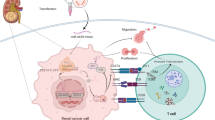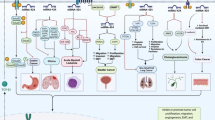Abstract
This study examined the internal mechanism of miR-210-3p/CELF2 in LUSC. Expression data of mRNAs and miRNAs in LUSC were acquired from TCGA and subjected to differential expression analysis. qRT-PCR was applied to examine miR-210-3p and CELF2 expression. Besides, western blot was utilized to evaluate protein expression of CELF2 and PI3K/AKT pathway-related proteins. Dual-luciferase reporter analysis was conducted to validate targeting relationship between miR-210-3p and CELF2. Additionally, CCK-8, colony formation, transwell and flow cytometry were employed to respectively test proliferation, migration, invasion abilities and cell cycle distribution. Xenograft tumor models were used to evaluate the influence of miR-210-3p and CELF2 on tumor growth. MiR-210-3p was highly expressed, while CELF2 was less expressed in LUSC cells. Besides, miR-210-3p could downregulate CELF2 expression. Cell functional assay verified that miR-210-3p accelerated aggressive behaviors of LUSC cells. Additionally, rescue assay suggested that miR-210-3p downregulated CELF2 level to stimulate LUSC cell phenotypes and cell cycle progression through PI3K/AKT pathway. Moreover, miR-210-3p/CELF2 stimulated the tumor growth in vivo. To sum up, miR-210-3p modulated CELF2 expression, thus affecting cell phenotypes and cell cycle distribution in LUSC through PI3K/AKT pathway.






Similar content being viewed by others
Data availability
The data that support the findings of this study are available on request from the corresponding author.
References
Higashi K, et al. 18F-FDG uptake as a biologic prognostic factor for recurrence in patients with surgically resected non-small cell lung cancer. J Nucl Med. 2002;43:39–45.
Sung H, et al. Global cancer statistics 2020: GLOBOCAN estimates of incidence and mortality worldwide for 36 cancers in 185 countries. CA: Cancer J Clin. 2021;71:209–49. https://doi.org/10.3322/caac.21660.
Wang J, Sheng Z, Yang W, Cai Y. Elevated serum concentration of chitinase 3-like 1 is an independent prognostic biomarker for poor survival in lung cancer patients. Cell Physiol Biochem. 2016;38:461–8. https://doi.org/10.1159/000438643.
Zhang Y, Li H, Han J, Zhang Y. Down-regulation of microRNA-124 is correlated with tumor metastasis and poor prognosis in patients with lung cancer. Int J Clin Exp Pathol. 2015;8:1967–72.
Chen J, et al. LINC00173.v1 promotes angiogenesis and progression of lung squamous cell carcinoma by sponging miR-511–5p to regulate VEGFA expression. Mol Cancer. 2020;19:98. https://doi.org/10.1186/s12943-020-01217-2.
Conti L, Gatt S. Squamous-cell carcinoma of the lung. N Engl J Med. 2018;379: e17. https://doi.org/10.1056/NEJMicm1802514.
Ferragut Cardoso AP, Udoh KT, States JC. Arsenic-induced changes in miRNA expression in cancer and other diseases. Toxicol Appl Pharmacol. 2020;409: 115306. https://doi.org/10.1016/j.taap.2020.115306.
Iorio MV, Croce CM. MicroRNA dysregulation in cancer: diagnostics, monitoring and therapeutics. A comprehensive review. EMBO Mol Med. 2012;4:143–59. https://doi.org/10.1002/emmm.201100209.
Esteller M. Non-coding RNAs in human disease. Nat Rev Genet. 2011;12:861–74. https://doi.org/10.1038/nrg3074.
Wu F, et al. miR-362-5p promotes cell proliferation and cell cycle progression by targeting GAS7 in acute myeloid leukemia. Hum Cell. 2020;33:405–15. https://doi.org/10.1007/s13577-019-00319-4.
Dong Z, et al. Investigation of targeting relationship between Micro-Rna-22 and Vegfr3 in lung squamous cell carcinoma. Comb Chem High Throughput Screen. 2021;24:148–54. https://doi.org/10.2174/1386207323666200720012917.
Chen Q, et al. miR-210-3p promotes lung cancer development and progression by modulating USF1 and PCGF3. Oncol Targets Ther. 2021;14:3687–700. https://doi.org/10.2147/ott.S288788.
Ren J, et al. miR-210-3p regulates the proliferation and apoptosis of non-small cell lung cancer cells by targeting SIN3A. Exp Ther Med. 2019;18:2565–73. https://doi.org/10.3892/etm.2019.7867.
Zhou L, Xie X. RNA-binding protein CELF2 inhibits breast cancer cell invasion and angiogenesis by downregulating NFATc1. Exp Ther Med. 2021;22:898. https://doi.org/10.3892/etm.2021.10330.
Yeung YT, et al. CELF2 suppresses non-small cell lung carcinoma growth by inhibiting the PREX2-PTEN interaction. Carcinogenesis. 2020;41:377–89. https://doi.org/10.1093/carcin/bgz113.
Fine B, et al. Activation of the PI3K pathway in cancer through inhibition of PTEN by exchange factor P-REX2a. Science (New York, NY). 2009;325:1261–5. https://doi.org/10.1126/science.1173569.
Wang L, et al. CELF2 is a candidate prognostic and immunotherapy biomarker in triple-negative breast cancer and lung squamous cell carcinoma: a pan-cancer analysis. J Cell Mol Med. 2021;25:7559–74. https://doi.org/10.1111/jcmm.16791.
Li Y, et al. Classification of glioma based on prognostic alternative splicing. BMC Med Genomics. 2019;12:165. https://doi.org/10.1186/s12920-019-0603-7.
Xie SC, et al. LncRNA CRNDE facilitates epigenetic suppression of CELF2 and LATS2 to promote proliferation, migration and chemoresistance in hepatocellular carcinoma. Cell Death Dis. 2020;11:676. https://doi.org/10.1038/s41419-020-02853-8.
Wang J, et al. miR-615–3p promotes proliferation and migration and inhibits apoptosis through its potential target CELF2 in gastric cancer. Biomedicine & pharmacotherapy = Biomedecine & pharmacotherapie. 2018;101:406–13. https://doi.org/10.1016/j.biopha.2018.02.104.
Vuletic A, Konjevic G, Milanovic D, Ruzdijic S, Jurisic V. Antiproliferative effect of 13-cis-retinoic acid is associated with granulocyte differentiation and decrease in cyclin B1 and Bcl-2 protein levels in G0/G1 arrested HL-60 cells. Pathol Oncol Res POR. 2010;16:393–401. https://doi.org/10.1007/s12253-009-9241-2.
Boyrie S, et al. RND1 regulates migration of human glioblastoma stem-like cells according to their anatomical localization and defines a prognostic signature in glioblastoma. Oncotarget. 2018;9:33788–803. https://doi.org/10.18632/oncotarget.26082.
Qin CD, et al. The Rho GTPase Rnd1 inhibits epithelial-mesenchymal transition in hepatocellular carcinoma and is a favorable anti-metastasis target. Cell Death Dis. 2018;9:486. https://doi.org/10.1038/s41419-018-0517-x.
Wu JZ, Jiang N, Lin JM, Liu X. STYXL1 promotes malignant progression of hepatocellular carcinoma via downregulating CELF2 through the PI3K/Akt pathway. Eur Rev Med Pharmacol Sci. 2020;24:2977–85. https://doi.org/10.26355/eurrev_202003_20662.
Tsai JH, Donaher JL, Murphy DA, Chau S, Yang J. Spatiotemporal regulation of epithelial-mesenchymal transition is essential for squamous cell carcinoma metastasis. Cancer Cell. 2012;22:725–36. https://doi.org/10.1016/j.ccr.2012.09.022.
Jurisic V, et al. EGFR polymorphism and survival of NSCLC patients treated with TKIs: a systematic review and meta-analysis. J Oncol. 2020;2020:1973241. https://doi.org/10.1155/2020/1973241.
Jurišić V, Obradovic J, Pavlović S, Djordjevic N. Epidermal growth factor receptor gene in non-small-cell lung cancer: the importance of promoter polymorphism investigation. Anal Cell Pathol (Amst). 2018;6192187:2018. https://doi.org/10.1155/2018/6192187.
Gao Y, Liu P, Shi R. Anlotinib as a molecular targeted therapy for tumors. Oncol Lett. 2020;20:1001–14. https://doi.org/10.3892/ol.2020.11685.
He H, et al. MiR-210-3p inhibits proliferation and migration of C6 cells by targeting Iscu. Neurochem Res. 2020;45:1813–24. https://doi.org/10.1007/s11064-020-03043-w.
Wang H, et al. OSCC exosomes regulate miR-210-3p targeting EFNA3 to promote oral cancer angiogenesis through the PI3K/AKT pathway. Biomed Res Int. 2020;2020:2125656. https://doi.org/10.1155/2020/2125656.
Switlik WZ, Karbownik MS, Suwalski M, Kozak J, Szemraj J. Serum miR-210-3p as a potential noninvasive biomarker of lung adenocarcinoma: a preliminary study. Genet Test Mol Biomarkers. 2019;23:353–8. https://doi.org/10.1089/gtmb.2018.0275.
Jeansonne D, et al. Anti-tumoral effects of miR-3189-3p in glioblastoma. J Biol Chem. 2015;290:8067–80. https://doi.org/10.1074/jbc.M114.633081.
Ben-Hamo R, Efroni S. MicroRNA regulation of molecular pathways as a generic mechanism and as a core disease phenotype. Oncotarget. 2015;6:1594–604. https://doi.org/10.18632/oncotarget.2734.
Acknowledgements
Not applicable.
Funding
Not applicable.
Author information
Authors and Affiliations
Contributions
All authors contributed to data analysis, drafting, and revising the article, gave final approval of the version to be published, and agreed to be accountable for all aspects of the work.
Corresponding author
Ethics declarations
Conflict of interest
No potential conflict of interest was reported by the authors.
Ethical approval
This study was conducted in accordance with the Helsinki Declaration II and was approved by the Institutional Review Boards of Sir Run Run Shaw Hospital, School of Medicine, Zhejiang University.
Additional information
Publisher's Note
Springer Nature remains neutral with regard to jurisdictional claims in published maps and institutional affiliations.
Rights and permissions
About this article
Cite this article
Zhang, Q., Wang, Y. MiR-210-3p targets CELF2 to facilitate progression of lung squamous carcinoma through PI3K/AKT pathway. Med Oncol 39, 161 (2022). https://doi.org/10.1007/s12032-022-01752-6
Received:
Accepted:
Published:
DOI: https://doi.org/10.1007/s12032-022-01752-6




